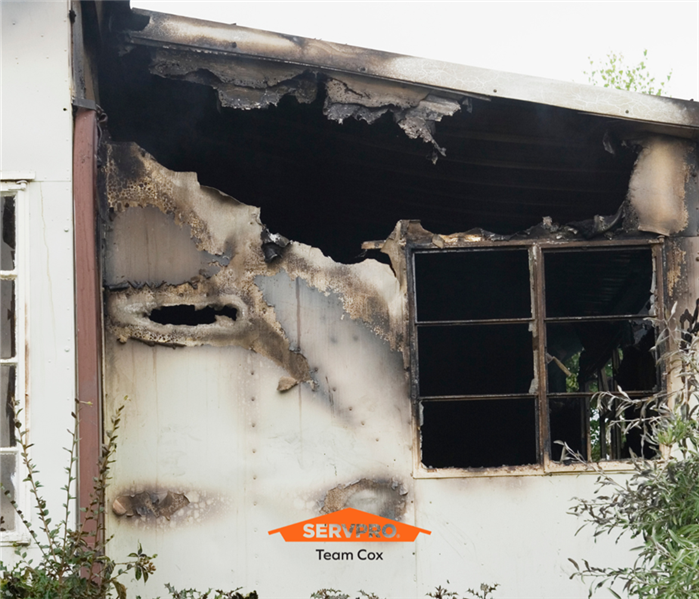Dealing with Fire Damage: Tackling Soot and Smoke Odor for a Fresh Start
11/13/2024 (Permalink)
After the flames are extinguished, the real challenges of fire damage begin to reveal themselves. For SERVPRO®, helping clients restore their spaces after a fire means addressing more than visible damage; it’s about eliminating every trace of soot and smoke odor that can linger long after the fire trucks have left. While soot and smoke may seem secondary to the initial destruction, their effects are lasting and pervasive, impacting everything from walls to air quality. Here’s how we tackle the often-overlooked impact of soot and smoke and help restore homes and businesses to pre-fire condition.
The Nature of Soot Damage: Why It's More Than Just a Surface Issue
Soot is made up of tiny, fine particles of carbon created during incomplete combustion. Despite its appearance as black or gray dust, it’s much more than a superficial nuisance. Soot is notorious for embedding itself into surfaces and materials, making it difficult to remove. In addition, its chemical composition often includes toxic substances, depending on what was burned, posing both immediate and long-term health risks if not properly addressed.
Areas Affected by Soot
Soot’s ability to infiltrate even the smallest crevices means it affects a wide variety of surfaces:
- Walls and Ceilings: Soot particles cling to walls and ceilings, leaving blackened stains and discoloration. Over time, these particles can damage paint and even lead to bubbling or peeling if left untreated.
- Carpet and Upholstery: Once soot particles settle into carpets and fabric, standard cleaning methods aren’t enough to lift them out. Attempting to remove soot without professional help can worsen the problem, pushing the particles deeper and potentially causing permanent staining.
- Wood and Metals: Even hard, non-porous surfaces like wood and metals aren’t immune. Soot can seep into wood grains, leaving stains, and can corrode metal surfaces, tarnishing their appearance and potentially leading to rust.
Smoke Odor: The Persistent Reminder of Fire
One of the most challenging aspects of fire damage is dealing with the residual smoke odor that permeates everything in its path. Smoke odor clings stubbornly to walls, furniture, carpets, and other porous materials. Its microscopic particles are able to penetrate deep into these materials, creating an odor that can linger indefinitely without professional intervention. Standard cleaning products can mask the smell temporarily, but they rarely eliminate it, making a comprehensive approach essential.
Why Smoke Odor is Hard to Eliminate
Smoke particles are incredibly small and can reach deep into porous materials like drywall, wood, and textiles. These particles can also infiltrate an HVAC system, spreading the odor throughout a building. This makes it difficult to isolate or contain smoke odor without specialized deodorization methods.
SERVPRO’s Systematic Approach to Fire Damage Restoration
SERVPRO Team Cox uses a detailed, multi-step process to ensure that no trace of soot or smoke odor is left behind. Our team brings experience and state-of-the-art equipment to each job, restoring properties to a safe, comfortable condition.
Step 1: Damage Assessment and Containment
The first step involves a full assessment to gauge the extent of soot and smoke damage and determine the best approach. We then set up containment barriers in affected areas to prevent soot particles from spreading. This keeps unaffected areas of the property clean while we work to restore the damaged sections.
Step 2: Soot Removal
Soot removal is a specialized process that requires professional-grade tools and expertise. Our technicians use cleaning agents that are specifically designed to remove soot from a variety of surfaces. For fabrics and carpets, we apply dry cleaning techniques to lift soot particles without damaging the material. In contrast, hard surfaces may need a more abrasive or chemical-based cleaning approach to fully remove soot particles without scratching or corroding the surface.
Step 3: Odor Neutralization for Smoke
To eliminate smoke odor, SERVPRO Team Cox uses a combination of deodorization methods that address odor at its source:
- Thermal Fogging: This technique involves heating and dispersing a fine mist of deodorizing agents that reach into the smallest crevices, neutralizing smoke particles at a molecular level.
- Ozone Treatment: For severe smoke odors, ozone generators release ozone molecules into the affected area, which break down smoke molecules and remove the odor. This method requires the building to be unoccupied during treatment, but it is highly effective for deep, stubborn odors.
- Hydroxyl Generators: This approach releases hydroxyl molecules that break down odor-causing compounds in a safe, continuous process. Unlike ozone, hydroxyl generators can be used safely in occupied spaces.
Step 4: Cleaning HVAC Systems
To prevent soot and smoke particles from recirculating throughout the property, our team inspects and cleans the HVAC system as part of the restoration process. Soot and smoke particles in the ventilation system can undermine the entire cleaning process, making HVAC cleaning an essential step in full restoration.
Step 5: Final Inspection and Air Quality Testing
Once soot and odor have been addressed, we conduct air quality tests to ensure the property is free from residual contaminants. This final inspection helps ensure the safety and comfort of occupants returning to the property.
Why SERVPRO Team Cox?
SERVPRO Team Cox is dedicated to restoring homes and businesses with a comprehensive approach that addresses not just visible damage, but also hidden issues like soot and smoke odor that can persist without professional intervention. With experience, advanced equipment, and a focus on customer satisfaction, we’re here to make fire damage “Like it never even happened.”
If you or someone you know is dealing with fire damage, SERVPRO Team Cox is ready to step in, bringing our expertise and compassion to help restore peace and normalcy in the wake of disaster. Call us at 704-393-7890.





 24/7 Emergency Service
24/7 Emergency Service
